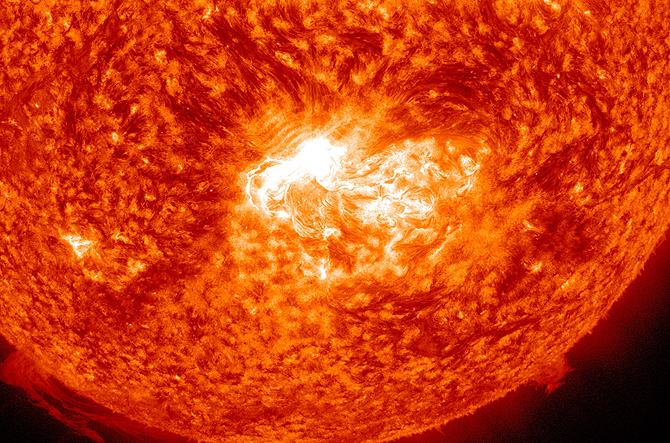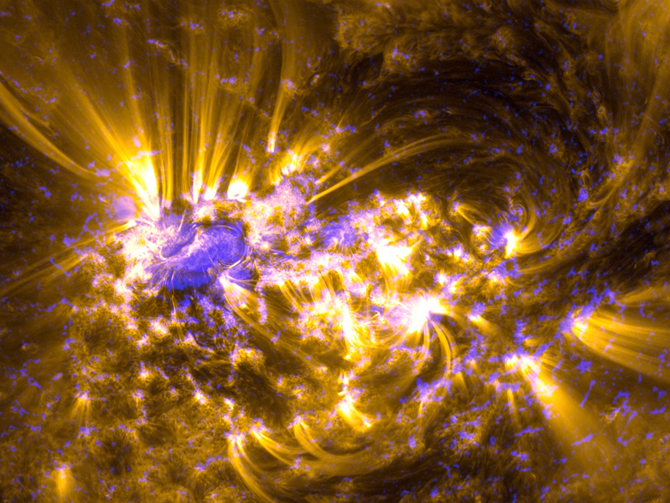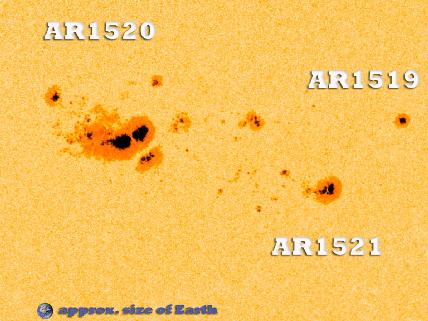News
Text Size
CME Arrival Results in Aurora Show
07.15.12
 › View larger
› View largerDan Bush's attempt to photograph the early morning planetary conjunction on Sunday, ended up catching some auroras as well. This photo was taken in Albany, Missouri. Image courtesy of Dan Bush.
Over the July 14-15, 2012 weekend and through the early morning of July 16, Earth experienced what's called a geomagnetic storm, which happens when the magnetic bubble around Earth, the magnetosphere, quickly changes shape and size in response to incoming energy from the sun. In this case that energy came from a coronal mass ejection (CME) associated with a July 12 X-class flare. Geomagnetic storms can create aurora visible at lower latitudes than usual, and aurora were spotted in the US as far south as Missouri and Arkansas.
| Sunspot 1520 Releases Strong Solar Flare and CME | 07.12.12 |
|
› Download hi-res video This movie shows the sun July 11-12, ending with the X1.4 class flare on July 12, 2012. It was captured by NASA’s Solar Dynamics Observatory in the 131 Angstrom wavelength — a wavelength that is particularly good for viewing solar flares and that is typically colorized in teal. Credit: NASA/SDO/AIA |
UPDATE: There is a coronal mass ejection (CME) associated with the July 12 X-class flare. Rough estimates based on the data currently available -- namely observations from STEREO-B (the Solar Terrestrial Relations Observatory) -- show that the CME is traveling in an Earth direction at over 850 miles per second.
 › View full disk image
› View full disk imageThis image from the Solar Dynamics Observatory shows the sun at 12:45 PM EDT on July 12, 2012 during an X1.4 class flare. The image is captured in the 304 Angstrom wavelength, which is typically colorized in red. Credit: NASA/SDO/AIA
 › View larger
› View full disk image
› View larger
› View full disk imageThis image combines two sets of observations of the sun at 10:45 AM EDT, July 12, 2012 from the Solar Dynamics Observatory (SDO) to give an impression of what the sun looked like shortly before it unleashed an X-class flare beginning at 12:11 PM EDT. The image incorporates light in the 171 Angstrom wavelength, which shows off giant loops of solar material overlying the middle of the sun over Active Region 1520 where the flare originated. The second set of observations is called a magnetogram, which highlights magnetic fields on the sun. Together these kinds of observations can help scientists understand the magnetic properties of the sun that lead to giant explosions like flares.
 › View large fulldisk image Credit: NASA/SDO/AIA
› View large fulldisk image Credit: NASA/SDO/AIA
An X1.4 class flare erupted from the center of the sun, peaking on July 12, 2012 at 12:52 PM EDT. It erupted from Active Region 1520 which rotated into view on July 6.
Further updates will be provided as needed.

|
› View larger This image taken by the Solar Dynamics Observatory's HMI instrument shows sunspot 1520 and it's regional neighbors, 1519 and 1521. Earth is shown to scale. Credit: NASA/SDO/HMI |
What is a solar flare? What is a coronal mass ejection?
For answers to these and other space weather questions, please visit the Spaceweather Frequently Asked Questions page.
Related Link
› View Past Solar Eruptions
NASA Goddard Space Flight Center, Greenbelt, MD